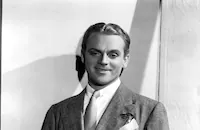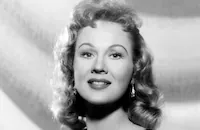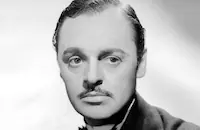The West Point Story

Brief Synopsis
Cast & Crew
Roy Del Ruth
James Cagney
Virginia Mayo
Doris Day
Gordon Macrae
Gene Nelson
Film Details
Technical Specs

Synopsis
When down-on-his-luck Broadway director Elwin "Bix" Bixby is offered a job by producer Harry Eberhart, Bix, who is estranged from Eberhart, turns the offer down sight unseen. After Bix's longtime girl friend, Eve Dillon, vows to leave him and take a job in Las Vegas, however, Bix agrees to talk to Eberhart. Eberhart wants Bix to direct the annual West Point "One Hundredth Night" show, which was written by Eberhart's nephew, Tom Fletcher. Bix, who hates West Pointers, having served under them in the war, again refuses the job. Eberhart then offers to have Eve's Las Vegas job canceled if Bix will convince Tom to perform in a Broadway production of his show. This changes Bix's mind and he leaves with Eve for West Point. Bix is impressed by the Academy's show and by Tom's talents but is continually frustrated by West Point regulations. During a quarrel, Bix hits a cadet and is almost fired, but the administration agrees to let him stay if he will become a cadet himself. When all of Bix's arguments fail to convince Tom to give up his military career for the stage, Bix invites movie star Jan Wilson to West Point to be Tom's date at the upperclass hop and recruits her to help persuade Tom to leave West Point. The more Jan listens to Tom's plans for the future, however, the less she is on Bix's side. Eventually, Jan and Tom fall in love. Meanwhile, Bix continues his West Point training and works on the show in his free time. When Bix learns that Jan and Tom have become engaged, he has her ordered back to California. Tom leaves the Academy to go after her, thereby jeopardizing his military career. After Jan tells Tom that her career plans will not allow her to marry him, Bix brings Tom back to West Point, where he is arrested and the show is canceled. Determined to save Tom's career, Eve learns that heads of state and diplomats can grant amnesty to cadets. Realizing that he was responsible for Tom's downfall, Bix resolves to bring the visiting French Premier to West Point to pardon the cadet. At first, the Premier refuses, but when Bix displays the Medaille Militaire that he won during the war, the Premier agrees to the plan. The show goes on, and Bix secretly arranges for Jan to perform in it. Tom and Jan are reconciled and plan to marry as soon as he graduates. Eberhart is furious when he learns that Tom will be staying in the military, and he becomes even angrier when the Academy presents Bix with the book and songs from the show so that he can produce it on Broadway.

Director

Roy Del Ruth
Cast

James Cagney

Virginia Mayo

Doris Day

Gordon Macrae

Gene Nelson

Alan Hale Jr.

Roland Winters
Raymond Roe
Wilton Graff

Jerome Cowan

Frank Ferguson
Glen Turnbull
Walter Ruick
John Hedloe
Stan Holbrook
Craag Cedar
Bob Hayden
Dewit Bishop
John Baer
David Post
James Stark
James Young
Tom Kelly
Edward Kerr
Don Shartel
Bill Neff
Chuck Courtney
Russ Saunders
Paul Mcguire
Walter Lenz
Sheridan Hall

Jack Kelly
Luther Crockett
Victor Desney
Wheaton Chambers
Guy De Vestal
Joe Mcguinn
Crew
Al Alleborn
Milo Anderson
Marjorie Best
Johnny Boyle Jr.
Paul Burnett
Sammy Cahn
Charles H. Clarke
Mel Dellar
Edwin Dupar
Louis F. Edelman
Morris Goldman
Ray Heindorf
Sid Hickox Jr.
Elva Hill
Charles Hoffman
Michael Joyce
Mac Julian
Ted Kring
Russ Llewellyn
Owen Marks
Armor E. Marlowe
Hugh Martin
L. P. "dudie" Mashmeyer
Lou Molina
John Monks Jr.
John More
Frank Perkins
George R. Poulton
Eddie Prinz
Leroy Prinz
Col. William G. Proctor
Ed Rike
Francis J. Scheid
Jule Styne
Irving Wallace
Irving Wallace
Gertrude Wheeler
Al White

Videos
Movie Clip




Trailer
Film Details
Technical Specs

Award Nominations
Best Score
Articles
The West Point Story
Because of his talent for playing lowlifes in films like The Public Enemy (1931) and White Heat (1949), Cagney's lasting film image is that of a gangster. What's often forgotten is that Cagney won his only Academy Award in the role of song man George M. Cohan in Yankee Doodle Dandy (1942) and that he actually began his acting career in vaudeville and in Broadway choruses. A small part in the play Penny Arcade led Cagney to Hollywood in 1930. He was brought west by Warner Bros. for a big screen adaptation of the play, renamed Sinner's Holiday (1930) (cast mate Joan Blondell also made the jump from stage to screen in this production). But it wouldn't take long for Cagney to find his niche in Hollywood. That came with the 1931 release of The Public Enemy and Cagney's defining screen mobster, Tom Powers. Yet, regardless of his tough guy persona, Cagney always considered himself a song and dance man and welcomed the chance to dispel his gangster image. Along with Yankee Doodle Dandy, there were Cagney pictures like Footlight Parade (1933) and A Midsummer Night's Dream (1935) where guns and crime didn't play into the action. But once again in 1949, as Cody Jarrett in White Heat, Cagney took on a role that would forever link him with the gangster genre. Still, despite the success of White Heat, or perhaps because of it, Cagney was determined that his next movie would be a musical.
And he jumped into the idea whole-heartedly. The story has it that one night after White Heat was finished, Cagney suggested to his wife and former vaudeville partner, that they perform their old act for friends. She challenged him to do it right then, on the spot. And so he did, only forgetting one line. After that, Cagney got busy planning his musical (he would have cast, script and director approval) and eventually found inspiration in a familiar place - the life of George M. Cohan. Cagney remembered that in preparing for one of his musicals, Cohan had been allowed to live as a cadet at West Point for a week. Thus the plot for The West Point Story was born. In the film, Cagney plays an out of work Broadway director roped into putting on the annual West Point student show "100 Nights" (so called because it's performed 100 nights before graduation) by a producer who believes his nephew (the show's writer) has talent. At West Point, Cagney runs into a few problems with the rules (mainly they interfere with his rehearsals) and is forced to live as a cadet for the remainder of his stay.
Joining Cagney in The West Point Story are Virginia Mayo as his girlfriend, Gordon MacRae as the writer and Doris Day as the star of the show. Cagney and Mayo were both coming from White Heat, their first movie together. But because Cagney needed time to have dances choreographed and to practice the numbers, he moved on to make Kiss Tomorrow Goodbye (1950) between White Heat and The West Point Story. During the filming of Kiss Tomorrow Goodbye, Cagney practiced with a stand-in for Mayo under the direction of choreographer John Boyle. Cagney's temporary dance partner (who he referred to simply by her last name Godfrey in his autobiography) was also said to have helped choreograph B'KLYN one of the best numbers in The West Point Story. But her efforts remained uncredited, much to Cagney's regret. He called the dancer, "one of the uncredited Hollywood crew people who made the pictures what they are." But using a stand-in caused more problems than just missing credits. It seems the young dancer, was lighter and smaller than Virginia Mayo. And at 5'6" Cagney wasn't a big man. So dancing with the heavier Mayo put a twist in the dance steps. As Mayo remembered, "[it was] a little problem, yes, that looked quite big at the time because I was a good head taller than the young lady choreographer and weighed a lot more. But we worked it out." Which meant that Cagney ended up wearing heels to make up the height difference. Apparently Cagney also had issues with dance director Le Roy Prinz, who in the actor's opinion "didn't know one foot from the other. He hated me," Cagney said. "He knew I was on to him."
But co-star Doris Day didn't hate Cagney. And the feeling was mutual. In The West Point Story, their first movie together, Cagney was immediately struck by Day's talent, saying, she had "the ability to project the simple, direct statement of a simple direct idea without cluttering it." Cagney was delighted to be paired with Day again in Love Me or Leave Me (1955), the real life story of torch singer Ruth Etting. In this picture, for the first time since 1939, Cagney would receive second billing to Day's starring turn. But billing didn't matter much when it came Oscar time. Love Me or Leave Me picked up one Academy Award, for Best Writing, and netted six more nominations, including a Best Actor nod for Cagney.
Looking back, Day would remember The West Point Story only as "an idiot picture" in which most of her scenes were with Gordon MacRae instead of Cagney. But Cagney himself would reflect on it more fondly, saying, "it's one of my favorite pictures. Cornball as all hell, but don't let anyone tell me those songs by Jule Styne and Sammy Cahn aren't worth listening to. They were worth dancing to."
Producer: Louis F. Edelman
Director: Roy Del Ruth
Screenplay: Charles Hoffman, John Monks, Jr., Irving Wallace
Art Direction: Charles H. Clarke
Cinematography: Sidney Hickox
Costume Design: Milo Anderson, Marjorie Best
Film Editing: Owen Marks
Original Music: Ray Heindorf
Principal Cast: James Cagney (Elwin Bixby), Virginia Mayo (Eve Dillon), Doris Day (Jan Wilson), Gordon MacRae (Tom Fletcher), Gene Nelson (Hal Courtland), Alan Hale, Jr. (Bull Gilbert), Roland Winters (Harry Eberhart), Jerome Cowan (Mr. Jocelyn).
BW-107m.
By Stephanie Thames

The West Point Story
Virginia Mayo (1920-2005)
She was born Virginia Clara Jones in St. Louis, Missouri on November 30, 1920, and got her show business start at the age of six by enrolling in her aunt's School of Dramatic Expression. While still in her teens, she joined the nightclub circuit, and after paying her dues for a few years traveling across the country, she eventually caught the eye of movie mogul Samuel Goldwyn. He gave her a small role in her first film, starring future husband, Michael O'Shea, in Jack London (1943). She then received minor billing as a "Goldwyn Girl," in the Danny Kaye farce, Up In Arms (1944). Almost immediately, Goldwyn saw her natural movement, comfort and ease in front of the camera, and in just her fourth film, she landed a plumb lead opposite Bob Hope in The Princess and the Pirate (1944). She proved a hit with moviegoers, and her next two films would be with her most frequent leading man, Danny Kaye: Wonder Man (1945), and The Kid from Brooklyn (1946). Both films were big hits, and the chemistry between Mayo and Kaye - the classy, reserved blonde beauty clashing with the hyperactive clown - was surprisingly successful.
Mayo did make a brief break from light comedy, and gave a good performance as Dana Andrews' unfaithful wife, Marie, in the popular post-war drama, The Best Years of Their Lives (1946); but despite the good reviews, she was back with Kaye in The Secret Life of Walter Mitty (1947), and A Song Is Born (1948).
It wasn't until the following year that Mayo got the chance to sink her teeth into a meaty role. That film, White Heat (1949), and her role, as Cody Jarrett's (James Cagney) sluttish, conniving wife, Verna, is memorable for the sheer ruthlessness of her performance. Remember, it was Verna who shot Cody¿s mother in the back, and yet when Cody confronts her after he escapes from prison to exact revenge for her death, Verna effectively places the blame on Big Ed (Steve Cochran):
Verna: I can't tell you Cody!
Cody: Tell me!
Verna: Ed...he shot her in the back!!!
Critics and fans purred over the newfound versatility, yet strangely, she never found a part as juicy as Verna again. Her next film, with Cagney, The West Point Story (1950), was a pleasant enough musical; but her role as Lady Wellesley in Captain Horatio Hornblower R.N. (1951), co-starring Gregory Peck, was merely decorative; that of a burlesque queen attempting to earn a university degree in the gormless comedy, She¿s Working Her Way Through College (1952); and worst of all, the Biblical bomb, The Silver Chalice (1954) which was, incidentally, Paul Newman's film debut, and is a film he still derides as the worst of his career.
Realizing that her future in movies was slowing down, she turned to the supper club circuit in the 60s with her husband, Michael O'Shea, touring the country in such productions as No, No Nanette, Barefoot in the Park, Hello Dolly, and Butterflies Are Free. Like most performers who had outdistanced their glory days with the film industry, Mayo turned to television for the next two decades, appearing in such shows as Night Gallery, Police Story, Murder She Wrote, and Remington Steele. She even earned a recurring role in the short-lived NBC soap opera, Santa Barbara (1984-85), playing an aging hoofer named "Peaches DeLight." Mayo was married to O'Shea from 1947 until his death in 1973. She is survived by their daughter, Mary Johnston; and three grandsons.
by Michael T. Toole
Virginia Mayo (1920-2005)
Quotes
Trivia
Notes
The film ends with the following written statement: "Warner Bros. acknowledges with grateful thanks the aid and cooperation provided by the United States Military Academy in making this picture possible." The "One Hundredth Night Show" is West Point's traditional variety show, so-called because it is staged one hundred days before June graduation. Director Roy Del Ruth appears as a corporal in the film. Ray Heindorf's score was nominated for an Academy Award.















